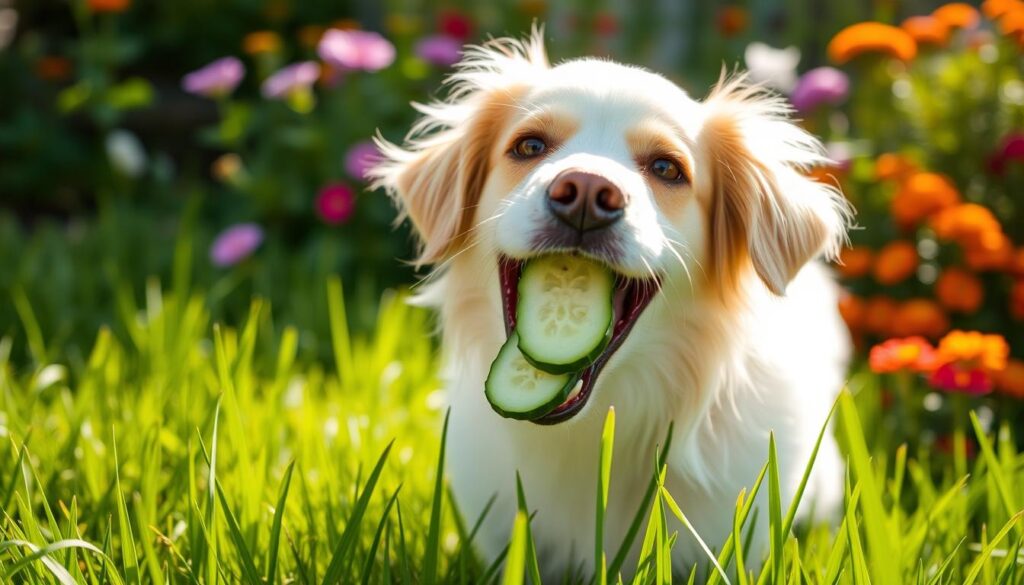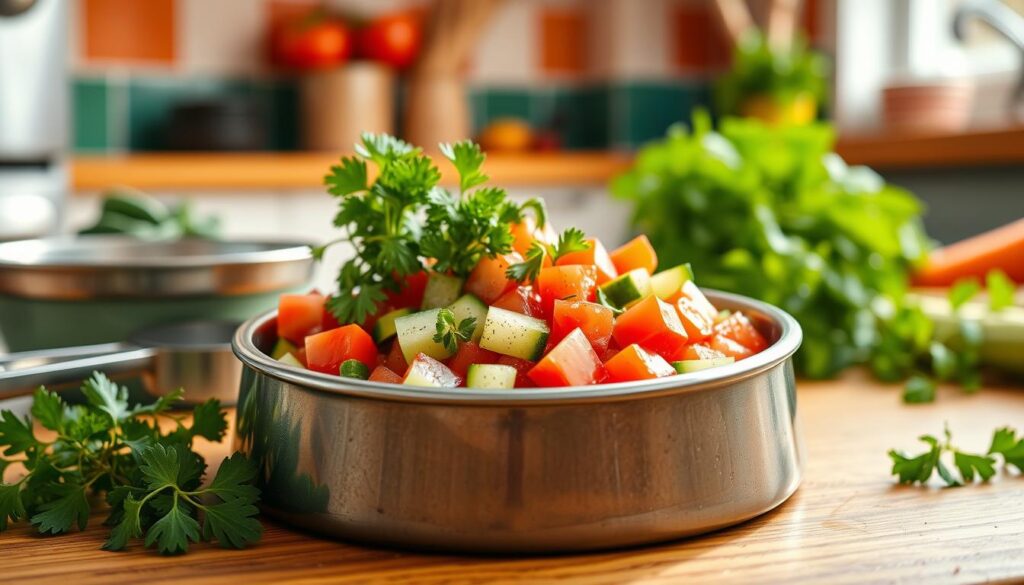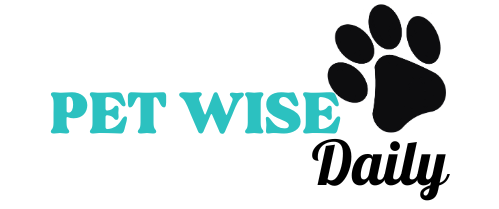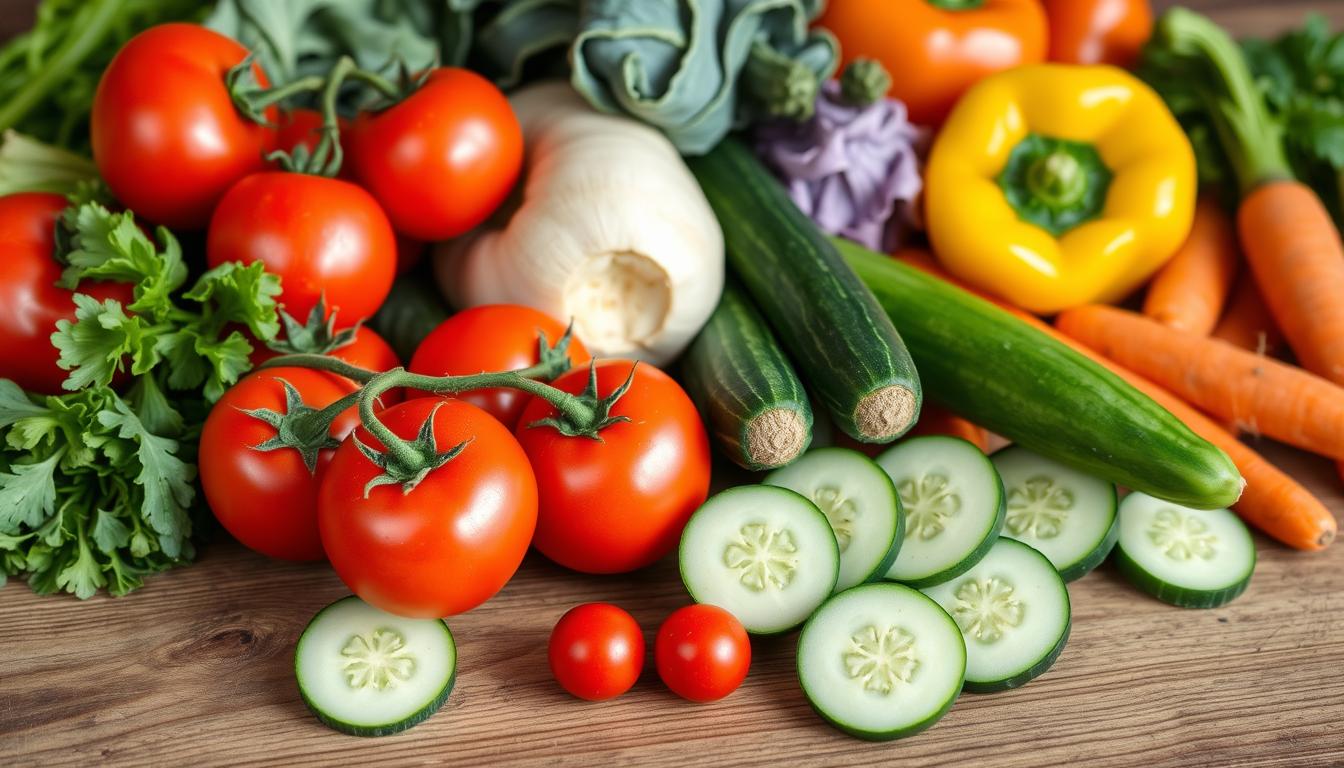Did you know 14 common veggies are safe for dogs? Favorites like broccoli, carrots, and cucumbers are on the list. It’s key to know the right amounts, but you can try new, healthy snacks for your dog.
In this guide, we’ll explore the benefits and risks of tomatoes and cucumbers for dogs. You’ll learn how to safely add them to your dog’s diet. By the end, you’ll know how to choose the best foods for your dog’s health.
Table of Contents
Understanding the Safety of Garden Vegetables for Dogs
Feeding your dog the right foods is key. Some garden veggies are safe, while others are not. Onions, garlic, and unripe tomatoes are toxic to dogs. But, many veggies are good for them.
Common Misconceptions About Dogs and Vegetables
Many think all human foods are bad for dogs. But, many veggies are safe and healthy. Knowing which veggies are safe is important.
Benefits of Adding Vegetables to Your Dog’s Diet
Vegetables are great for dogs. They help with weight, digestion, and immune health. Pumpkin, broccoli, carrots, and green beans are especially good.
The Importance of Proper Portion Control
Vegetables are good, but watch the amounts. Too much of some veggies can upset their stomach. Always check with your vet for the right amounts.
Adding safe veggies to your dog’s diet is good for their health. Knowing what’s safe lets you give them the best food for their well-being.
Can Dogs Eat Tomatoes and Cucumbers?
Many dog owners like to share their food with their pets. But, when it comes to tomatoes and cucumbers, there’s more to it. Ripe tomatoes and cucumbers are okay for dogs, but there are some things to remember.
Ripe tomatoes are safe and good for dogs because they have vitamins A and C. But, the green parts of the tomato plant and unripe tomatoes have solanine and tomatine. These can make dogs sick, causing stomach problems and drowsiness.
Cucumbers are a good choice for dogs. They are low in calories and full of vitamins. They also have a nice crunch that dogs enjoy.
Remember, eggs are okay for dogs, but onions are not. Onions can harm a dog’s red blood cells and cause anemia.
It’s important to not overdo it with treats. Tomatoes and cucumbers should only be 10% of your dog’s daily food. Always talk to your vet before adding new foods to your dog’s diet.
The Health Benefits of Cucumbers for Dogs
Cucumbers are great for dogs, offering many health benefits. They are refreshing and hydrating. They also give dogs important vitamins and minerals.
Nutritional Value of Cucumbers
Cucumbers are mostly water, making them very hydrating for dogs. They have magnesium, potassium, and vitamins C, B, and K. These help support your dog’s immune system, bones, and heart.
Hydration Benefits
Cucumbers are full of water, perfect for hydrating dogs on hot days or when they’re active. Keeping your dog hydrated is key for their health and avoiding dehydration.
Low-Calorie Treat Option
Cucumbers are low in calories, great for dogs that need to lose weight. They are a healthy dog treat that’s good for weight management and taste.
When giving cucumbers to your dog, remove the skin and seeds to avoid digestive problems. Vets say to cut cucumbers into small pieces for easy chewing and digestion.
Cucumbers are a dog-friendly food that offers many health benefits. Adding them to your dog’s diet can help with hydration, nutrition, and overall health.
Safe Ways to Serve Cucumbers to Your Dog
Cucumbers can be a refreshing treat for your dog. It’s key to prepare them safely. Start by washing the cucumbers well to remove pesticides. Choose organic cucumbers to avoid harmful chemicals.
For small dogs, remove the seeds to avoid choking. Cut the cucumbers into small pieces for easy eating. The peel is usually safe, but some dogs might find it hard to digest. You can peel them if your dog has trouble.
- Wash cucumbers thoroughly to remove pesticides
- Organic cucumbers are preferable
- Remove seeds for smaller dogs to prevent choking
- Slice cucumbers into bite-sized pieces
- Cucumber peel is safe but may be tough for some dogs to digest
Start with small amounts of cucumbers to see how your dog reacts. Some dogs might have sensitivities or digestive issues with veggies. Frozen cucumber pieces can be a cool summer healthy dog snack.
| Vegetable | Nutritional Benefits for Dogs |
|---|---|
| Carrots | High in fiber and beta-carotene, contributing to healthy vision and immune system |
| Green Beans | Low in calories, high in fiber, and a good source of Vitamins A, C, and K |
| Broccoli | Rich in Vitamins C and K, fiber, and antioxidants, supporting immune system and reducing inflammation |
| Sweet Potatoes | Good source of fiber, Vitamins A, C, B6, and minerals like manganese and potassium, promoting digestive health and a shiny coat |
| Peas | Rich source of Vitamins A, B, and K, along with minerals like iron and potassium, beneficial for digestion and muscle health |
By following these safe preparation methods, you can confidently dog food preparation and serve cucumbers as a refreshing and nutritious addition to your dog’s diet.

Understanding Tomatoes: Benefits and Risks
Tomatoes are a common vegetable in many homes. It’s natural to wonder if they’re safe for dogs. The good news is that ripe, red tomatoes can be good for dogs. They provide important vitamins and antioxidants.
But, it’s important to know the risks of certain tomato parts.
Ripe vs. Unripe Tomatoes
Ripe, red tomatoes are safe for dogs in small amounts. They are full of vitamins A, C, and K, and antioxidants. These help keep your dog healthy.
But, unripe, green tomatoes and tomato plant leaves and stems are not safe. They have a compound called tomatine. This can be harmful to dogs.
Parts of the Tomato Plant to Avoid
The stems, leaves, and unripe tomatoes have more tomatine. This can cause stomach problems, tiredness, and weakness in dogs. It’s important to keep dogs away from these parts.
Signs of Tomato Plant Toxicity
If your dog eats parts of the tomato plant, watch for signs of toxicity. Look for vomiting, diarrhea, loss of appetite, and tiredness. If you think your dog ate a lot of the plant, get vet help right away.
In short, ripe tomatoes can be a healthy snack for dogs in small amounts. But, avoid the leaves, stems, and unripe fruits. Always talk to your vet before adding new foods to your dog’s diet.
How to Safely Prepare Tomatoes for Your Dog
Feeding tomatoes to your dog needs care and simple steps. Ripe, red tomatoes are good for dogs, giving them important vitamins and antioxidants. But, you must prepare them right to keep your dog safe.
- Choose Ripe, Red Tomatoes: Only use fully ripe, red tomatoes. Avoid unripe, green tomatoes. The green parts of the tomato plant, like stems and leaves, have solanine. This can be toxic to dogs in big amounts.
- Remove the Stems and Leaves: Take off the stems, leaves, and any green parts from the tomatoes before giving them to your dog. These parts can harm if eaten.
- Wash Thoroughly: Wash the ripe, red tomatoes well. This removes any pesticides or contaminants.
- Cut into Bite-Sized Pieces: Cut the tomatoes into small pieces. This helps prevent choking and makes them easy for your dog to eat.
- Avoid Canned or Processed Tomatoes: Don’t use canned tomatoes or tomato-based products. They might have garlic, onions, or too much salt, which can harm dogs.
- Introduce Tomatoes Gradually: Start with small amounts of tomatoes in your dog’s diet. Watch for any bad reactions, like stomach problems or skin issues.
By following these steps, you can add the good stuff from ripe, red tomatoes to your dog’s healthy dog snacks and dog food preparation. Always talk to your vet before changing your dog’s diet a lot.
Foods to Avoid When Feeding Vegetables to Dogs
Dogs can benefit from some vegetables, but there are dangerous ones to avoid. These veggies can harm your dog’s health and should not be given to them.
- Onions, garlic, and leeks – These belong to the Allium family and contain compounds that can damage red blood cells, leading to anemia.
- Wild mushrooms – Many types of mushrooms are toxic and can cause vomiting, diarrhea, liver damage, or even death if consumed by dogs.
- Green potatoes – The green parts of potatoes contain solanine, a toxic compound that can lead to digestive issues and neurological problems.
It’s also wise to avoid canned vegetables because of their high sodium and preservatives. Corn on the cob is dangerous because it can cause choking.
Knowing what veggies can dogs not eat is key. But, be careful with high-fiber veggies like cauliflower. They can upset your dog’s stomach. Always introduce new foods slowly and in small amounts to watch for any reactions.
| Vegetable | Reason to Avoid |
|---|---|
| Onions, garlic, leeks | Can damage red blood cells, leading to anemia |
| Wild mushrooms | Many types are toxic and can cause severe health issues |
| Green potatoes | Contain solanine, a toxic compound that can lead to digestive and neurological problems |
| Canned vegetables | High in sodium and preservatives, which can be harmful to dogs |
| Corn on the cob | Poses a serious choking hazard |
| High-fiber vegetables (e.g., cauliflower) | Can cause gas and digestive discomfort in some dogs |
By knowing which toxic foods for dogs to avoid, you can safely add veggies to their diet. This way, your dog can enjoy the health benefits of vegetables.
Portion Guidelines and Feeding Tips
Adding cucumbers and tomatoes to your dog’s diet should be done with care. Treats, including these, should not make up more than 10% of their daily calories. This helps keep their diet balanced and nutritious.
Size-Based Serving Recommendations
The right amount of cucumbers depends on your dog’s size. Start with a small slice for small dogs and up to a quarter cup for bigger ones. Remember, only give ripe, red tomatoes, as the green parts are toxic.
Weekly Feeding Schedule
- Give cucumbers and tomatoes 1-2 times a week as treats.
- Adjust the amount based on your dog’s size, age, and how active they are.
- Watch how your dog reacts to these new foods to make sure they’re okay with them.
Signs of Digestive Issues to Watch For
Even though cucumbers and tomatoes are usually safe, some dogs might not like them. Look out for vomiting, diarrhea, or if they don’t want to eat. If you see any of these, stop giving them the veggies and talk to your vet.

By following these tips and watching what your dog needs, you can add cucumbers and tomatoes to their diet safely. This way, you help keep them healthy and happy.
Conclusion
Tomatoes and cucumbers can be good treats for dogs if given right. Make sure to give only ripe, red cherry tomatoes. Avoid the green parts because they’re toxic.
Cucumbers are a cool, hydrating snack that’s low in calories. They’re great for hot days.
When adding safe vegetables for dogs to their diet, do it slowly and in small amounts. Watch for any bad reactions. If you’re worried, talk to your vet.
Remember, these dog-friendly foods are extra treats, not a full meal. They should not replace a balanced diet your vet recommends.
Knowing the good and bad of garden veggies helps you choose the right ones for your dog. With some care, you can give your dog tasty and healthy dog-friendly foods.


Частная наркологическая клиника: вернём вам свободу от зависимости
наркологический центр в спб [url=http://platnaya-narkologicheskaya-klinika.ru/]http://platnaya-narkologicheskaya-klinika.ru/[/url] .
Алкоголь с доставкой на дом в любое время: широкий ассортимент и комфортный сервис 24/7
как купить алкоголь с доставкой на дом [url=https://www.dostavka-alcogolya-nochyu-world.ru]https://www.dostavka-alcogolya-nochyu-world.ru[/url] .
Удобная доставка алкоголя на дом: заказывайте онлайн без лишних хлопот
доставка алкоголя [url=https://dostavka-alcogolya-nochyu-club.ru/]доставка алкоголя[/url] .
Современные фронтальные погрузчики с расширенными возможностями
купить фронтальный погрузчик небольшой [url=https://xn—-7sbkqfclcqchgmgkx0ae6eudta.xn--p1ai/]купить фронтальный погрузчик небольшой[/url] .
Быстрая доставка алкоголя: напитки для любого настроения и повода
алкоголь круглосуточно [url=https://www.dostavka-alcogolya-nochyu-lux7.ru/]https://www.dostavka-alcogolya-nochyu-lux7.ru/[/url] .
Установка фильтров для воды: услуги сантехника для улучшения качества водоснабжения
сантехник [url=http://www.24santehnick-1.ru/]http://www.24santehnick-1.ru/[/url] .
Экспертный подход к антимонопольным вопросам: услуги профессионального юриста
жалоба в фас юрист [url=https://antimonopolnii-yurist.ru/]https://antimonopolnii-yurist.ru/[/url] .
Топовые ставки и слоты доступны на официальном сайте Mostbet
mostbet.com uz [url=https://www.mostbet-uz-bet.top/]https://www.mostbet-uz-bet.top/[/url] .
Услуги сантехника для малогабаритных ванных комнат: компактные решения
сантехник спб срочно [url=https://remontson1.ru]https://remontson1.ru[/url] .
Выездной сантехник: оперативные услуги и устранение аварийных ситуаций
услуги сантехника [url=http://san-mon.ru]http://san-mon.ru[/url] .
Топ-10 вопросов о суррогатном материнстве: ответы юристов и врачей
суррогатное материнство [url=http://www.mammalogy.su/]http://www.mammalogy.su/[/url] .
Как арендовать квартиру на сутки в Гродно: пошаговая инструкция
снять квартиру на сутки [url=http://newgrodno.ru/]http://newgrodno.ru/[/url] .
Стационарное лечение в наркологической клинике: комфортные условия и уход
наркологическая клиника телефон [url=http://platnaya-narkologicheskaya-klinika1.ru/]http://platnaya-narkologicheskaya-klinika1.ru/[/url] .
Just thinking about you gives me chills… come closer – https://rb.gy/es66fc?drieby
Rubber stamp maker: add text, icons, and borders without downloads
stamp maker [url=https://www.make-stamp-online0.com/]https://www.make-stamp-online0.com/[/url] .
Stamp creator online: ideal for startups needing quick branding solutions
online stamp design maker [url=https://make-stamp-online1.com/]online stamp design maker[/url] .
Продажа кабин для горной и карьерной спецтехники — защита от экстремальных нагрузок
куплю кабину для спецтехники [url=https://www.xn—–6kceqhatfamjizg3a7au2dr1h5d.xn--p1ai]https://www.xn—–6kceqhatfamjizg3a7au2dr1h5d.xn--p1ai[/url] .
Кабины для спецтехники от европейских поставщиков — качество подтверждено сертификатами
кабины спецтехники [url=https://xn—–6kceqhatfamjizg3a7au2dr1h5d.xn--p1ai]https://xn—–6kceqhatfamjizg3a7au2dr1h5d.xn--p1ai[/url] .
Stamp maker online: pre-made templates for businesses and individuals
online stamp maker free [url=https://make-stamp-online-0.com]https://make-stamp-online-0.com[/url] .
Fast online stamp maker: Create stamps for any purpose
create stamp online free [url=https://make-stamp-online-1.com/]https://make-stamp-online-1.com/[/url] .